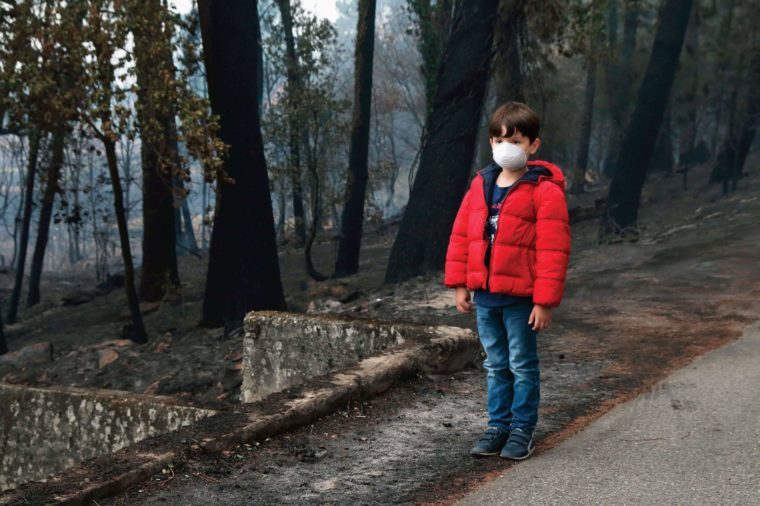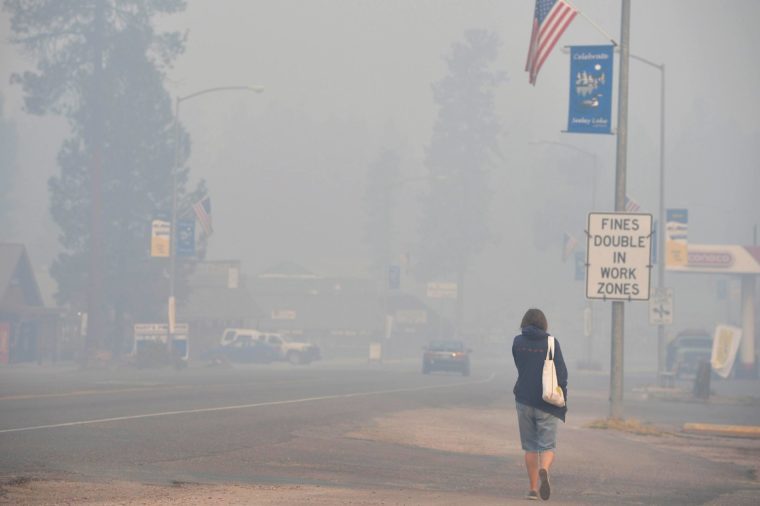
It’s late August when I get a call from a grandmother. She lives in Seeley Lake, Montana, and she has heard we have air purifiers with high-efficiency particulate air (HEPA) filters that can help with smoke. She needs one for the baby’s room. I explain we don’t have any and tell her how to purchase one. She coughs and goes silent before asking how much they cost. Almost every person I talk to in Seeley Lake has this cough. The family doesn’t have much money, she says, but she promises to order a filter for the child. Small filters—ones that can clean a bedroom of up to 75 square feet—cost about $70 each. The next day, the wildfire that has been burning for weeks in the Lolo National Forest, northeast of town, moves closer to the woman’s neighborhood, and the county sheriff’s office evacuates it. I wonder whether the filter will be there when the family returns home. I know the smoke will be.
As an air-quality specialist with the Missoula City-County Health Department in Montana, my job is to understand air pollution, control it as much as possible, and help people protect themselves from its effects. I focus on smoke management: issuing permits for outdoor burns and updating residents about what to expect from the smoke when wildfires send it our way.
If my job were only about how smoke moves, it would be simple. Not easy, mind you—wildfire smoke is flashy and weird. It’s just that focusing purely on the science would be fun for a smoke nerd like me.
But last July, thunderstorms trekked across western Montana, igniting a ring of fires around Missoula County. One by one, they started blowing up, smothering small towns in smoke. The massive Rice Ridge Fire burned directly above the community of Seeley Lake, and every night smoke filled the valley, building by the hour and creating dangerous breathing conditions the likes of which we had never seen. To our south, the Lolo Peak Fire sent daily smoke to the Bitterroot Valley, frequently creating dangerous, unbreathable air for its residents.
Never had we seen so many wildfires so close to home for so many weeks. There are six categories on the Environmental Protection Agency’s Air Quality Index: good, moderate, unhealthy for sensitive groups, unhealthy, very unhealthy, and hazardous. Seeley Lake’s air reached hazardous on 18 days last summer.
Last year was plagued by wildfires around the country. The blazes that struck Northern California alone killed 44 people and caused more than $9 billion in damage. But this isn’t just a recent problem, nor is it confined to the West. Wildfires hit 49 states in 2017, including a swath from Florida to Virginia. More than 9 million acres burned nationwide, compared with the yearly average of 6.5 million acres.
Communities that are nowhere near a wildfire can be affected too. One NOAA-NASA satellite showed that smoke from this past summer’s western wildfires traveled along the jet stream as far east as New York and Pennsylvania. Sometimes, such long-distance smoke merely creates a haze on the horizon. Other times, it lands in full force, exposing new areas to potentially dangerous levels of particulate.
Content continues below ad

It’s that particulate matter—pollutant so fine that it can enter your bloodstream when you breathe it in—that makes smoke so dangerous. The elderly, people with heart or lung disease, pregnant women, and children are most at risk. Fine particulate comes from sources other than wildfires, too: Smokestacks, cars, power plants, woodstoves, and fireplaces all contribute. In many parts of the country, particularly in New England, a considerable fraction of air pollution comes from woodsmoke from homes, especially in the winter.
Particulate matter is a cumulative pollutant, so the more you’re exposed to it, the worse it is for you. It aggravates asthma symptoms and causes reduced lung function and wheeziness. A recent Harvard University study of Americans age 65 and older found that when the concentration of particulates rose by just ten micrograms per cubic meter, the chances that a person would die during the 12 years the study analyzed increased 7.3 percent. Those researchers also found that reducing fine particulate pollution by just one microgram per cubic meter nationwide could save about 12,000 lives each year. (These are the other damaging ways air pollution affects your body.)
The pollution can be particularly difficult to escape in mountain regions like my part of Montana. When smoke descends on the valley, the world shrinks. Anything more than a block away disappears behind a white wall of smoke. The birds are quiet. Smoke makes its way through door and window cracks. It follows ventilation systems into homes.
Without a filtration system, the indoors provides no refuge. And in rural Montana, where air-conditioning is rare, most residents open their windows at night to seek relief from the hot, stuffy summer air, even amid the smoke. The air warms enough in the afternoons to rise and take the smoke with it, providing a few precious hours of respite. But every night it descends, and every morning it stays longer in the valley than it did the day before.

In the absence of central air systems with filtration for fine particulates, the best defense against the smoke is a HEPA filter, which can reduce the fine particulate in a room by more than 99 percent. But while wildfire smoke has become increasingly common since 2000, HEPA room filters are not yet a standard feature in homes. (Look out for these potential fire hazards indoor own home.)
And when a wildfire moves into your area, that lack of protection can create widespread health problems. The National Ambient Air Quality Standard for fine particulate matter averaged over 24 hours is 35 micrograms in a cubic meter of air. During last year’s fires, our monitor in Seeley Lake registered 1,000, as high as the machine goes.
As the fires burned, I heard from teachers, parents, coaches, health-care workers, and retirees. They called asking where they could go to escape the smoke. They wanted to know how to protect themselves, what kind of room filters would work, whether they should wear a mask. They pleaded for filters I didn’t have. They asked questions I couldn’t always answer. A child had come home sick from school—why had the windows been open? The soccer team was expected to play in the smoke—why hadn’t the game been canceled?
Content continues below ad
There was smoke inside the Seeley Lake clinic. The nurses were sick. A patient in the clinic said the smoke made him want to die. An asthmatic grandmother living in Seeley Lake had just gotten custody of her one-year-old grandson, but she was sick from the smoke and worried for the child. A housebound couple had survived pneumonia three times that year, and the husband was on oxygen. They were a mile from the fire. Please help, they asked. I tried.
Some requests were easier than others. I tracked down school athletic directors to make sure the people arranging soccer games followed the correct guidance—if the air quality was rated as unhealthy or worse, cancel the games. I pulled up a map and figured out how close the cleanest air was so some people could try to escape the smoke for short periods of time. I looked at weather patterns and models and made projections about when the smoke would be likely to clear or worsen. I shared information about HEPA room filters and explained how they could help create a safe space—usually a bedroom—in a home. But the smoke in Seeley Lake thickened on a daily basis. I talked to my supervisors, and we sent out an official recommendation that residents leave the area until the smoke cleared. Few took our advice. Few had anywhere to go. (Find out what these natural disaster survivors wish they’d done differently to prepare.)

I called the director of Climate Smart Missoula, which has launched a pilot project to provide HEPA room filters to the elderly, and pleaded for help. They came through with 25 filters for health clinic patients. I called state agencies and asked for money to buy filters but was left empty-handed. I called the Seeley Lake and Lolo elementary schools and asked whether they had filtered air for their students. They didn’t. We raided our health department budget and purchased 40 HEPA room filters for the schools. The manufacturer gave us a discount, cutting their retail price from $170 to $127. Climate Smart Missoula ordered 45 more, with support from the community. When children’s health is at risk, the director explained, you don’t wait on details.
I called my contact at the American Lung Association, and she immediately contacted headquarters. They had some money, but I sent it to the next county over, where, on that day, the need was greater. I took calls from surrounding counties asking what to do. I sent them what information I had.
I began shuffling filters and trying to find filters on a near-daily basis. There was an elementary school in Condon where 23 students were sitting in smoke so thick that visibility had dropped to less than half a mile; we sent them eight. One day, I received three requests for filters I didn’t have—two for babies and one for a choking elderly couple. I took their information and promised to try to help. And then I put my head in my hands and wept.
Throughout it all, I sent updates about the smoke: where it was going, how bad it would get, how people could protect themselves. I sprinkled the updates with smoke jokes because it’s my survival mechanism and maybe it would help others. People tell me it does. But every night, while I lie in my bed with my filter gently whirring beside me, I know there are vulnerable people sleeping unprotected.
And I know—in another year, in another valley—the smoke will come back. I take comfort knowing that when it does, we won’t have to scramble. After weeks of frantic activity, we’ve laid the groundwork to protect our communities from smoke: educating the public, creating safe spaces for vulnerable residents, building a reserve supply of filters—and we’ve seen our efforts expand throughout western Montana.
To our knowledge, our push to get HEPA filters into the community last summer was a first in the country. And currently, I’m in talks with the Environmental Protection Agency about packaging what we did here for other communities in the United States. Every bit of preparedness helps.
The post An Expert Explains Why Wildfire Smoke Is Way More Dangerous Than You Realized appeared first on Reader's Digest.
from Reader's Digest http://ift.tt/2C3861G
No comments :
Post a Comment